The Nilgiri Biosphere Reserve
The Nilgiri Biosphere Reserve
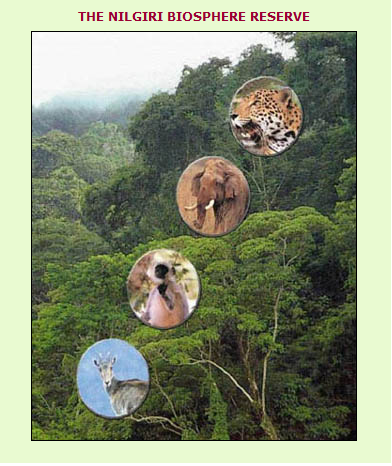
The Nilgiri Biosphere Reserve was the first biosphere reserve in India established in the year 1986. It is located in the Western Ghats and includes 2 of the 10 biogeographical provinces of India. Wide ranges of ecosystems and species diversity are found in this region. Thus, it was a natural choice for the premier biosphere reserve of the country.
- The Nilgiri Biosphere Reserve was established mainly to fulfill the following objectives:
- To conserve insitu genetic diversity of species
- To restore degraded ecosystems to their natural conditions
- To provide baseline data for ecological and environmental research and education
- To function as an alternate model for sustainable development
Geography
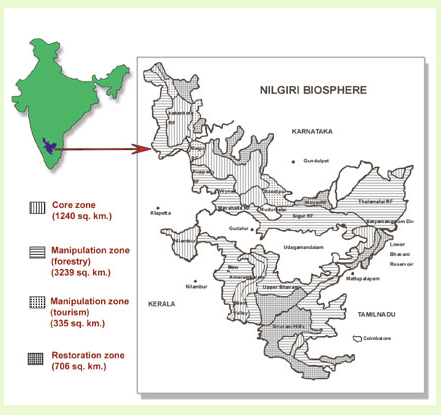 The total area of the Nilgiri Biosphere Reserve is 5,520 sq. km. It is located in the Western Ghats between 76°- 77°15‘E and 11°15‘ - 12°15‘N. The Nilgiri Biosphere Reserve encompasses parts of Tamilnadu, Kerala and Karnataka. The annual rainfall of the reserve ranges from 500 mm to 7000 mm with temperature ranging from 0°C during winter to 41°C during summer.
The total area of the Nilgiri Biosphere Reserve is 5,520 sq. km. It is located in the Western Ghats between 76°- 77°15‘E and 11°15‘ - 12°15‘N. The Nilgiri Biosphere Reserve encompasses parts of Tamilnadu, Kerala and Karnataka. The annual rainfall of the reserve ranges from 500 mm to 7000 mm with temperature ranging from 0°C during winter to 41°C during summer.
The Nilgiri Biosphere Reserve falls under the biogeographic region of the Malabar rain forest. The Mudumalai Wildlife Sanctuary, Wyanaad Wildlife Sanctuary Bandipur National Park, Nagarhole National Park, Mukurthi National Park and Silent Valley are the protected areas present within this reserve.
| State | Area(Sq. Kms) |
| Tamilnadu | 2537.6 |
| Kerala | 1455.4 |
| Karnataka | 1527.4 |
Vegetation
The Nilgiri Biosphere Reserve comprises of substantial unspoilt areas of natural vegetation ranging from dry scrub to evergreen forests and swamps thus contributing to highest biodiversity. The altitude and climatic gradients support and nourish the different vegetational types.
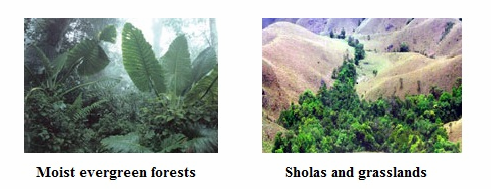
|
Vegetational Types of the Nilgiri Biosphere Reserve |
|||
|
S.No |
Forest type |
Nature of Vegetation |
Area of occurrence |
|
1 |
Moist evergreen |
Dense, moist and multi storeyed forest with gigantic trees |
In the narrow valleys of Silent Valley |
|
2 |
Semi evergreen |
Moist, deciduous |
Nilambur and Palghat division |
|
3 |
Thorn |
Dense |
North east part of the Nilgiri district |
|
4 |
Savannah woodland |
Trees scattered amid woodland |
Mudumalai and Bandipur |
|
5 |
Sholas & grasslands |
High elevated evergreen with grasslands |
South and western catchment area, Mukurthi national park |
Flora

 The Nilgiri Biosphere Reserve is very rich in plant diversity. About 3,300 species of flowering plants can be seen here. Of the 3,300 species 132 are endemic to the Nilgiri Biosphere Reserve. The genus Baeolepis is exclusively endemic to the Nilgiris. Some of the plants entirely restricted to the Nilgiri Biosphere Reserve include species of Adenoon, Calacanthus, Baeolepis, Frerea, Jarodina, Wagatea, Poeciloneuron, etc.
The Nilgiri Biosphere Reserve is very rich in plant diversity. About 3,300 species of flowering plants can be seen here. Of the 3,300 species 132 are endemic to the Nilgiri Biosphere Reserve. The genus Baeolepis is exclusively endemic to the Nilgiris. Some of the plants entirely restricted to the Nilgiri Biosphere Reserve include species of Adenoon, Calacanthus, Baeolepis, Frerea, Jarodina, Wagatea, Poeciloneuron, etc.
Of the 175 species of orchids found in the Nilgiri Biosphere Reserve, 8 are endemic to the Nilgiri Biosphere Reserve. These include endemic and endangered species of Vanda, Liparis, Bulbophyllum, Spiranthes and Thrixspermum. The sholasof the Nilgiri BiosphereReserve are a treasure house of rare plant species.
|
Plant type |
No. of species |
|
Angiosperms |
3238 |
|
Gymnosperms |
71 |
|
Pteridophytes |
134 |
Fauna
The fauna of the Nilgiri Biosphere Reserve includesover over 100 species of mammals, 350 species of birds, 80 species of reptiles and amphibians, 300 species of butterflies and innumerable invertebrates. 39 species of fish, 31 amphibians and 60 species of reptiles endemic to the Western Ghats also occur in the Nilgiri Biosphere Reserve. Fresh water fish such as Danio neilgheriensis,Hypselobarbusdubuis and Puntius bovanicus are restricted to the Nilgiri BiosphereReserve. The Nilgiri tahr, Nilgiri langur, slender loris, blackbuck, tiger, gaur, Indian elephant and marten aresome of the animals found here.
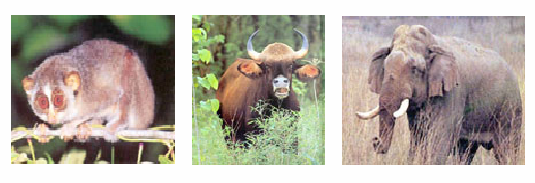
Water resources
The Nilgiri  Biosphere Reserve is one of the critical catchment areas of peninsular India. Many of the major tributaries of the river Cauvery like the Bhavani, Moyar, Kabini and other rivers like Chaliyar, Punampuzha, etc., have their source and catchment areas within the reserve boundary. Many hydroelectric power projects are present in the Kundah, Bhavani and Moyar basins .
The sholas and grasslands play a very important role in retaining water and supplying it to these streams. A drastic decline in the sholas and grasslands is one of the reasons for the recent water scarcity in the Nilgiri Biosphere Reserve.
The people
 A variety of human cultural diversity can be found in the Nilgiri Biosphere Reserve. The increase in population is attributed to migration from surrounding areas rather than the population growth ofindigenous people.
A variety of human cultural diversity can be found in the Nilgiri Biosphere Reserve. The increase in population is attributed to migration from surrounding areas rather than the population growth ofindigenous people.
Tribal groups like the Todas, Kotas, Irullas, Kurumbas, Paniyas, Adiyans, Edanadan Chettis, Cholanaickens, Allar, Malayan, etc., are native to the reserve. Except for Cholanaickens who live exclusively on food gathering, hunting and fishing, all the other tribalgroups are involved in their traditional occupation of agriculture.
Problems of the Nilgiri Biosphere Reserve
The Nilgiri Biosphere Reserve has been enduring human interference for a very long time through development projects such as hydroelectric power projects, agriculture, horticulture, etc., which have brought about substantial change in the ecology of the area. Many environmental problems are noticed in different parts of the Nilgiri Biosphere Reserve.
Intensive felling
The increase in influx of population from the surrounding areas has led to deforestation and consequent habitat destruction. Between 1990 – 96 there has been a decrease in the dense forest area. 28.96 sq. km. of dense forests have become open forest and 22.67 sq. km. of dense forests have changed into non-forest areas. Intensive felling has led to multiple problems like destruction, depletion and degradation of the environment and its natural .resources.Indiscriminate clearing of forestsis destroying the habitat of the several species of animals and birds of the Nilgiris. Some of them like the Nilgiri wood pigeon, Nilgiri pipet and Nilgiri langur that are endemic to this region have hence become highly endangered. Animals like the elephant, tiger and leopard are moving closer to human settlements owing to the shrinking of forest areas.
Plantations (monoculture)
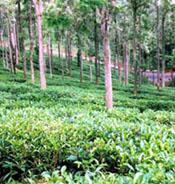 The Nilgiris, which support a variety of tree species, are threatened by monoculture. The sholas are being destroyed for plantations. Monoculture of eucalyptus, wattle, blue gum, cash crops like tea, coffee, cardamom and food crops like potato have degraded the soil quality along with excessive use of fertilizers. The tea bushes require frequent appli cation of fertilizer, which has made the soil porous. During heavy rain, these slopes are easily washed away resulting in a landslide
The Nilgiris, which support a variety of tree species, are threatened by monoculture. The sholas are being destroyed for plantations. Monoculture of eucalyptus, wattle, blue gum, cash crops like tea, coffee, cardamom and food crops like potato have degraded the soil quality along with excessive use of fertilizers. The tea bushes require frequent appli cation of fertilizer, which has made the soil porous. During heavy rain, these slopes are easily washed away resulting in a landslide
Grazing
The sholas were used for grazing cattle. The livestock population inside the Nilgiri Biosphere Reserve is very low but the population in the periphery is very high. Destruction of the sholas has led to disappearance of perennial streams, causing soil erosion and micro climatic changes. Overgrazing has led to degradation of low and high level grasslands, which harbour a large number of endemic species.
Forest fires
Forest fires are more common in the sholas and dry deciduous forests. They are both accidental as well as deliberate. The annual fire set off during the summer months for a better pasture in the ensuing monsoon is another manmade threat to the biological diversity.
Development and construction activity
Due to developmental activities large areas of forests have been cleared in and around the Nilgiri Biosphere Reserve. More human habitation has resulted in largescale road laying that connects even remote forest areas to the nearest urban centre. Construction activities like road building have unleashed widespread landslides and slope destabilization. Construction of the Kabini reservoir has submerged the valley between Nagarhole and Bandipur.
Horticultural and agricultural practices
Extension of agriculture, and use of lands unsuited for agriculture have accelerated soil erosion. Human settlements on the uplands have destroyed the sholas. Soil erosion is severe in the east and southwest areas of the Nilgiris where the monsoons are heavy. In the Mysore plateau region, the extension of irrigation canals from reservoirs has led to a largescale shift in land practices.
Tourism
The Nilgiris are an important tourist centre in South India, and attract a large number of tourists. A large number of hotels, clubs, resorts, gardens and roads have emerged rapidly,degrading the natural vegetation. Extensive pollution and water scarcity are the result affecting the entire ecology Nilgiri Biosphere Reserve. The Ooty Lake has been ruined accumulating garbage and disposal of sewage into it.
Conservation and management of the Nilgiri Biosphere Reserve
Conservation and management of the Nilgiri Biosphere Reserve depends on the coordination between government agencies and the local people. For effective management, the Nilgiri Biosphere Reserve has been zonalised as
- core zone (1240 sq.km)
- buffer zone (4280 sq.km)
The buffer zone is further divided into manipulation zones like forestry, tourism and recreation zones. These zones are located in all the three states of Tamilnadu, Karnataka and Kerala into which the Nilgiri Biosphere Reserve extends. Most of the plantations are seen only in the manipulation zone.
Being one of the hotspots of biodiversity, the Nilgiri Biosphere Reserve has some national parks and wildlife sanctuaries within its boundaries. Conservation of wildlife is the main objective of these national parks and wildlife sanctuaries. Some of these areas have been designated by the government as Project Tiger and Project Elephant areas.
|
Mudumalai wildlife sanctuary (321 sq.km) |
|
|
Location |
N.W. corner of Nilgiri plateau, Tamilnadu |
|
Elevation |
800 to 1000 m. |
|
Vegetation |
dry deciduos scrub |
|
Fauna |
elephant, sambar, gaur, Indian giant squirrel, Nilgiri langur and bonnet macaque |
|
Mukurthi National Park (80 sq.km) |
|
|
Location |
S.E. corner of the Nilgiri plateau, Tamilnadu |
|
Elevation |
2400 m. |
|
Vegetation |
Sholas and grasslands |
|
Fauna |
Nilgiri tahr (state animal of Tamilnadu) |
|
Bandipur National Park (800 sq.km) |
|
|
Location |
Convergence of the Eastern and Western Ghats, Karnataka |
|
Elevation |
800 m. |
|
Vegetation |
Ranges from moist deciduous to scrub |
|
Fauna |
Elephant, gaur, sambar, barking deer, sloth bear, jackal, wildboar, Malabar squirrel, chowsingha, etc. |
|
Nagarhole National Park (Rajiv Gandhi National Park) (572 sq.km) |
|
|
Location |
S.E. part of Kodagu district, Karnataka |
|
Vegetation |
Deciduous forest interspersed with swamps |
|
Fauna |
Elephant, chital, sambar, munjtac, tiger, leopard and wild dog |
|
Wyanaad Wildlife Sanctuary (344 sq.km) |
|
|
Location |
Kerala |
|
Elevation |
600 to 1100 m |
|
Vegetation |
Moist dry deciduous |
|
Fauna |
Elephant, sambar, chital, tiger, wild dog and leopard, freshwater fish like Travancoria, Bhavania and Bargus |
|
Silent Valley National Park (78 sq.km) |
|
|
Location |
Kerala |
|
Elevation |
2712.42 m. |
|
Vegetation |
Evergreen with grasslands |
|
Fauna |
Lion tailed macaque, Nilgiri marten and Nilgiri tahr |
Conclusion
Apart from preserving biological and cultural diversity, the Nilgiri Biosphere Reserve also provides ecological sustainability to the entire region. Research and monitoring of the management and conservation of the natural wealth of the Nilgiri Biosphere Reserve are being carried out by various government institutions and departments. A commitment to conserve this natural treasure house of resources is the need of the hour. This can be achieved only by the participation and co-operation of the local people in the conservation programmes.
Last Modified : 1/8/2021
This page provides information about the World Tou...
This page covers information about land resources ...
This topic provides information about Indian Adven...
This topic provides information about Must see her...
